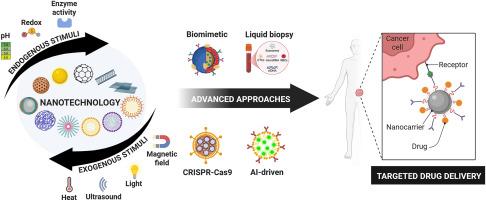刺激反应纳米颗粒在癌症治疗中的进展:机制、功能材料和新兴技术
IF 4.9
3区 医学
Q1 PHARMACOLOGY & PHARMACY
Journal of Drug Delivery Science and Technology
Pub Date : 2025-09-11
DOI:10.1016/j.jddst.2025.107519
引用次数: 0
摘要
癌症是一种多因素疾病,因此需要不同的治疗策略来阻止其进展和复发。传统疗法如化疗和放疗,虽然广泛使用,但存在局限性,包括低特异性、全身毒性和耐药性。在这种情况下,纳米技术作为一种很有前途的非侵入性方法出现了,它提供了增强的靶向性、控制药物释放和减少副作用。这篇重要的综述整合了刺激响应智能纳米颗粒的最新进展,包括聚合物、脂基和无机纳米载体,同时强调了它们的机制方面和转化方面的挑战。特别强调外源性和内源性刺激响应纳米颗粒,如pH、氧化还原、酶和磁场响应纳米材料,它们能够实现位点特异性药物激活并最大限度地减少脱靶效应。此外,我们还讨论了尖端技术,包括用于基因沉默的装载crispr - cas9的纳米颗粒,用于精密医学的人工智能驱动的纳米颗粒建模,用于增强生物相容性的仿生纳米颗粒,以及用于早期癌症检测的液体活检集成纳米诊断。纳米材料的多样性及其在不同类别中的作用被评估,以通过使用一系列治疗剂来改善癌症治疗。尽管具有潜力,但我们的分析强调了纳米颗粒为基础的递送系统在临床应用中的几个挑战,包括稳定性、毒性、长期安全性和监管方面。这种全面和综合的方法为指导未来肿瘤智能纳米药物的研究和临床转化提供了新的见解。本文章由计算机程序翻译,如有差异,请以英文原文为准。

Advances in stimuli-responsive nanoparticles for cancer therapy: Mechanisms, functional materials, and emerging technologies
Cancer is a multifactorial disease and hence demands different therapeutic strategies to arrest its progression and recurrence. Conventional therapies such as chemotherapy and radiotherapy, while widely used, present limitations, including low specificity, systemic toxicity, and drug resistance. In this context, nanotechnology has emerged as a promising non-invasive approach, offering enhanced targeting, controlled drug release, and reduced side effects. This critical review integrates the latest advancements in stimuli-responsive smart nanoparticles, including polymeric, lipid-based, and inorganic nanocarriers, while emphasizing both their mechanistic aspects and translational challenges. Special emphasis is given to exogenous and endogenous stimuli-responsive nanoparticles, such as pH, redox, enzyme, and magnetic field-responsive nanomaterials, which enable site-specific drug activation and minimize off-target effects. Furthermore, we discuss cutting-edge technologies, including CRISPR-Cas9-loaded nanoparticles for gene silencing, AI-driven nanoparticle modeling for precision medicine, biomimetic nanoparticles for enhanced biocompatibility, and liquid biopsy-integrated nanodiagnostics for early cancer detection. The diversity of nanomaterials and their action in different classes is evaluated to improve cancer treatment by using a range of therapeutic agents. Despite their potential, our analysis highlights several challenges for the clinical application of nanoparticle-based delivery systems, including stability, toxicity, long-term safety, and regulatory aspects. This comprehensive and integrative approach provides new insights to guide future research and clinical translation of smart nanomedicine in oncology.
求助全文
通过发布文献求助,成功后即可免费获取论文全文。
去求助
来源期刊
CiteScore
8.00
自引率
8.00%
发文量
879
审稿时长
94 days
期刊介绍:
The Journal of Drug Delivery Science and Technology is an international journal devoted to drug delivery and pharmaceutical technology. The journal covers all innovative aspects of all pharmaceutical dosage forms and the most advanced research on controlled release, bioavailability and drug absorption, nanomedicines, gene delivery, tissue engineering, etc. Hot topics, related to manufacturing processes and quality control, are also welcomed.

 求助内容:
求助内容: 应助结果提醒方式:
应助结果提醒方式:


